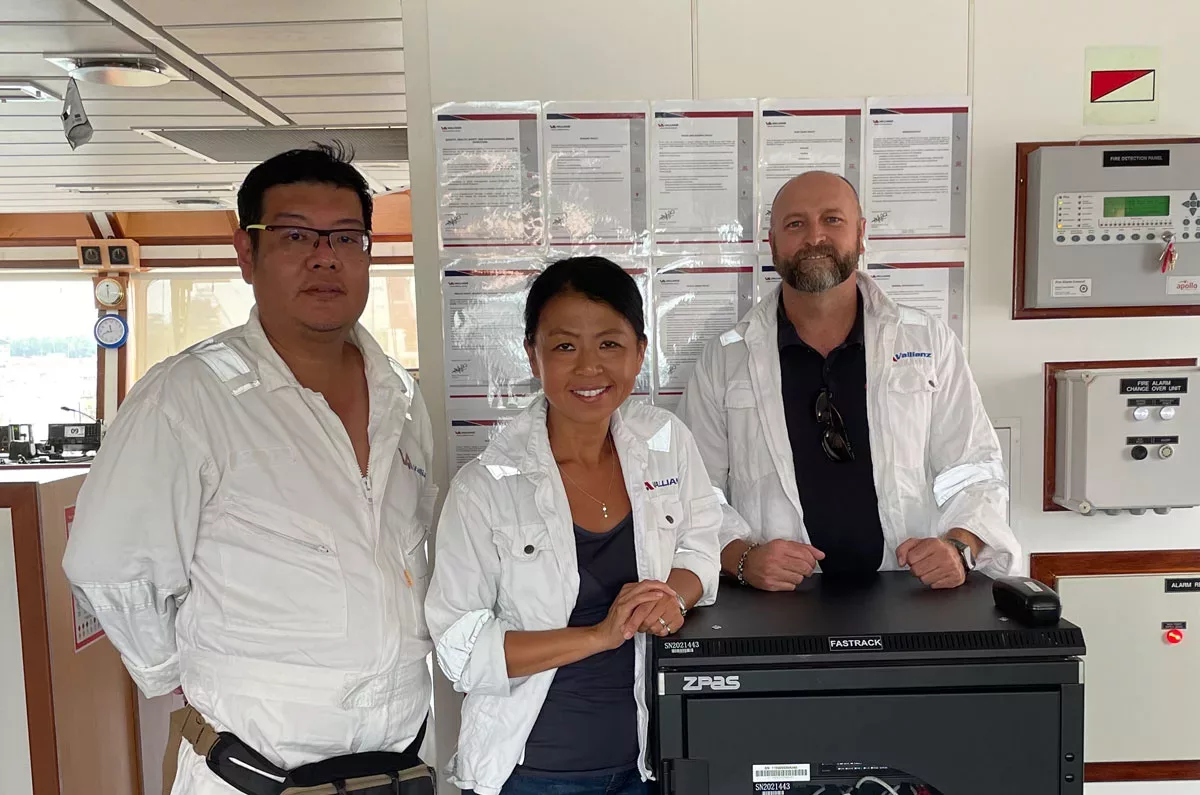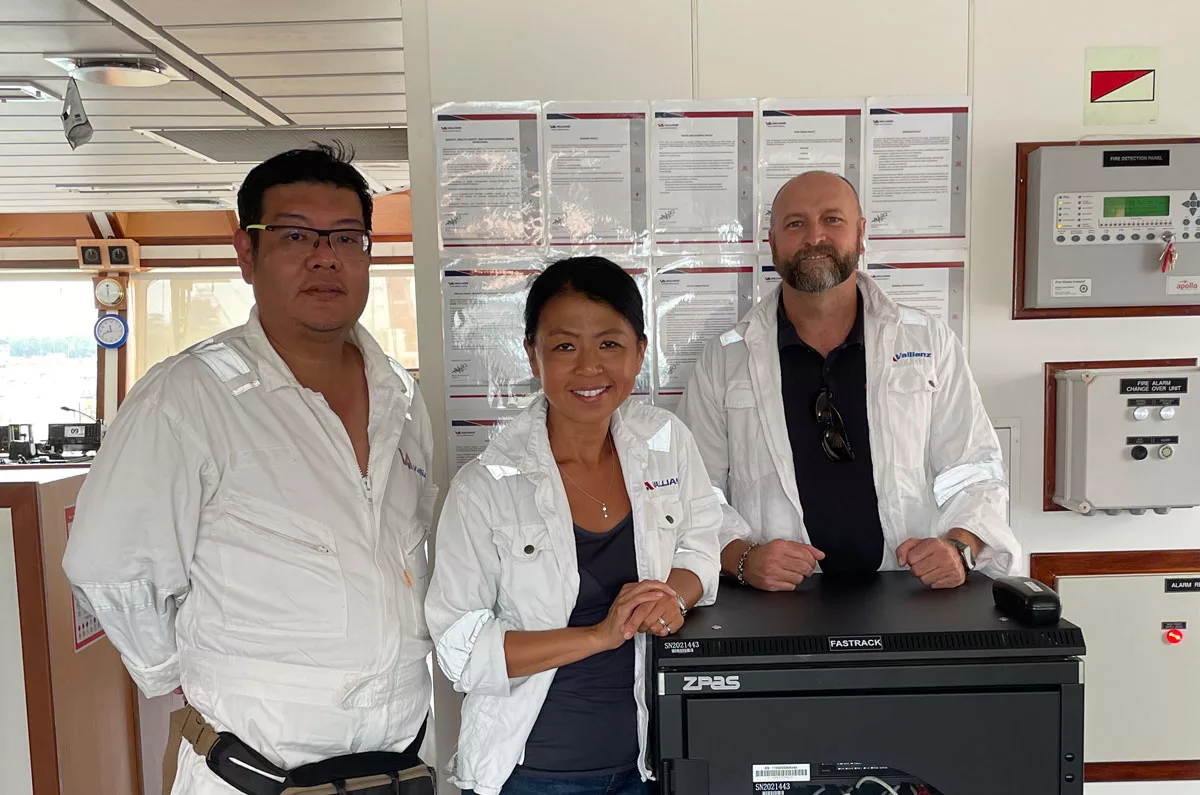
Elisa Woodward (centre), Vallianz Head of Engineering, New Building and Technology pictured with Kenneth Tan Teck Gee (left), Vallianz Senior Engineer and Jimmy Dean (right), HTG Head of Solutions Architecture.
As Head of Engineering, New Building and Technology at Vallianz, Elisa Woodward has her sights firmly set on the future of the maritime industry. With a passion for digitalisation, she is leading the charge to integrate cutting-edge technology into Vallianz’s latest showcase vessel, the “Vallianz Prestige”. In a recent conversation, Elisa discusses the exciting partnership between Vallianz and Harvest Technology Group, which promises to bring innovative solutions to the maritime industry. Based in Singapore but regularly traveling for business, Elisa has blazed a trail for female engineers in the industry, having worked closely with the Saudi Arabia Oil Major on various projects.
Tell us about Vallianz…
Vallianz provides high-value vessel solutions – conventional or alternative – to external clients for supporting the offshore energy business. This includes transportation and support services to offshore structures and projects, some of which have been one-of-a-kind solutions adopted by tier one oil majors.
What value does Harvest’s technology add?
Incorporating Harvest’s technology has brought a tremendous value-add to our operations. The maritime industry has been on a trajectory of digitalisation for the past decade, and we at Vallianz are committed to staying ahead of the curve. Harvest’s digital solution for real-time monitoring of our vessels using CCTV has revolutionised our operations. With this technology, we can support our crew and monitor operations remotely, saving time, energy, and resources that would have been expended on travel and logistics. It eliminates the complexities of finding crew, flight shortages, visa issues, and the like, ensuring seamless operations and enhanced efficiency.
What other benefits has digitalisation bought to your workplace?
Through digitalising a lot of our operations, any of our staff can access the V-Hub – our central hub – and see what our vessels are doing. We have the digital means to access the information rather than emailing the ship or having to be in Singapore to physically talk to the operations team. Digitalisation has really benefited the younger generation, but also the older team who have realised it helps ease the burden of keeping track of so many things going on. The ease of digitalising our assets has proven itself and benefited the general public and the team who are working with vessels now.
Are there any challenges that come with digitalisation?
The rising demand for alternative energy sources has sparked a global surge in offshore solutions. As water makes up over 70% of the Earth’s surface, offshore operations present an optimal approach for harnessing energy. This has led to the development of various offshore vessels and ships equipped with increasingly sophisticated technology. However, there is a significant shortage of skilled crew members to operate these vessels, as proper training for positions like Chief Engineer or Captain takes 8-10 years. The Vallianz Group, encompassing Saudi entity Rawabi Vallianz Offshore Services, has expanded its fleet from just two vessels in the early 2010s to over 140 today, with continued growth expected. Each vessel requires at least 20 crew members, translating to a need for 2,800 personnel. Consequently, digitalizing vessel operations is essential to managing the group’s expanding fleet and ensuring efficient vessel management.
Do you have an update on the new-build DP2 ‘Vallianz Prestige’ vessel?
Vallianz Prestige has been operational for the past couple of months and is our first showcase vessel and fleet to implement a complete digital solution. Not only have we utilised Harvest’s CCTV live streaming technology, but we’ve also integrated remote monitoring for vessel performance, which includes equipment monitoring, navigation and communication monitoring, and fuel monitoring. On top of that, digital twinning has been conducted, where we’ve taken a 3D scan of the vessel, allowing one to digitally walk through our vessel and see the critical specifications or updates on different equipment and areas. That feeds back into our V-Hub, and you can monitor it from there.
What drives your commitment to digitalise remote operations?
The growing demand for alternative energy has led to a surge in offshore solutions worldwide. Offshore operations are the best solution for developing energy harnessing because water covers over 70 per cent of the earth’s surface. As a result, many different types of offshore vessels and ships have been built to support such activities, leading to a vast increase in vessel equipment and technology complexity. However, there’s a shortage of qualified and capable crew to operate these vessels due to the extended time required for proper training. It takes at least 8-10 years to properly train a cadet to a Chief Engineer or Captain. At Vallianz, we have grown from a fleet of two vessels in the early 2010s to over 140 vessels today and are still growing. With at least 20 crew members per vessel, we need to deploy at least 2,800 personnel on our vessels. Therefore, digitalising our vessel operations is a necessary step to manage our growing fleet and maintain efficient vessel management.
What do you love about your job?
I love that my job allows me to contribute to the maritime industry in meaningful ways, especially in terms of driving digitalisation and innovation. It’s also important to me to show other women that there are many opportunities in our industry, and that they too can make valuable contributions. The shipping/maritime industry is a very exciting one for a woman to work in. And of course, there are some unique and memorable experiences that come with working in this field – for example, I gave birth to both of my children while working in production at a shipyard. People always laugh when I tell them that story!
What is the most remote location you’ve ever worked?
A few years back, I had the opportunity to access an restricted locations in Saudi Arabia as part of a team tasked with developing vessel solutions. It was definitely a challenging experience, both logistically and culturally. As a woman, I had to go through a lot of approvals and clearances from the coast guard just to access these restricted locations. But looking back, I’m proud to have been the first woman to access such facilities.
Follow Harvest Technology Group on LinkedIn for our latest news and updates.
